Amanita franchetii (Boud.) Fayod - Gilded Amanita
Phylum: Basidiomycota - Class: Agaricomycetes - Order: Agaricales - Family: Amanitaceae
Distribution - Taxonomic History - Etymology - Identification - Culinary Notes - Reference Sources
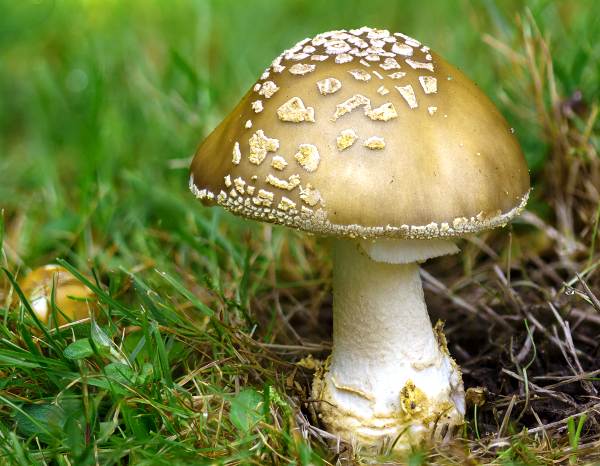
The striking sulphur-yellow veil of Amanita franchetii is its most distinctive feature; however, the veil fragments lose a lot of their colour as the fruitbody matures.
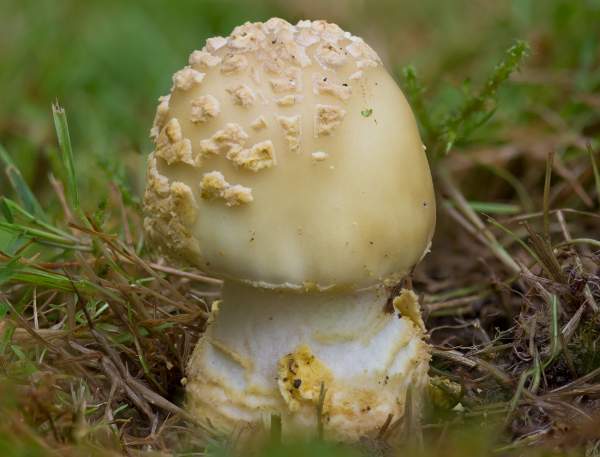
Distribution
A rare to occasional find in Britain and Ireland, Amanita franchetii occurs also in many parts of mainland Europe. A similar species, Amanita augusta, occurs in western parts of the USA.
Taxonomic history
This species was first described scientifically in 1881 by the French mycologist Jean-Louis Émile Boudier, who named it Amanita aspera var. franchetii. The currently-accepted scientific name Amanita franchetii dates from an 1889 publication by Swiss mycologist Victor Fayod.
Synonyms of Amanita franchetii include Amanita aspera var. franchetii Boud., and Amanita queletii var. franchetii (Boud.) Bon.
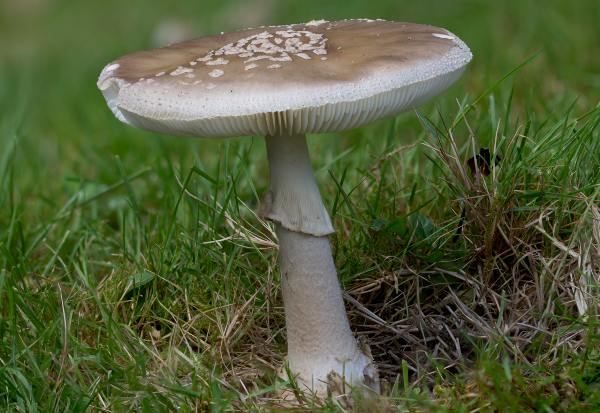
Above: a mature fruitbody. Note the brownish edge to the pendent ring.
Etymology
The specific epithet franchetii honours the French botanist Adrien René Franchet (1834 - 1900).
For a detailed description of the Amanita genus and identification of common species see our Simple Amanita Key...
Identification guide
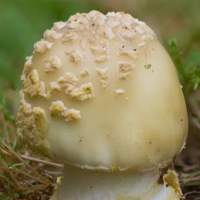 |
Cap4 to 8cm wide, citrine yellow to yellow ochre, hemispherical then convex, finally planar and often slightly depressed in the center when old. Veil breaks up into small flat or pyramidal yellowish scales. Cap flesh is white with a thin pale yellow region just below the cap skin. Flesh does not redden when cut or bruised, |
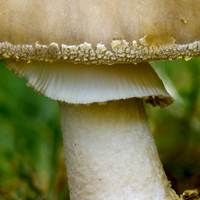 |
GillsFree, white and moderately spaced. StemThe stem is 5 to 8cm long and 1 to 2cm in diameter, tapering from a bulbous base ringed with yellowish scales. Stem surface is white. A superior to median pendent membranous ring is grooved on its upper surface and has a yellow-brown woolly edge. |
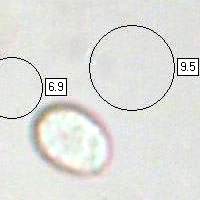 |
SporesBroadly ellipsoid, 8-11.5 x 6-8μm; amyloid.
Spore printWhite. |
Odour/taste |
Not ditinctive. |
Habitat & Ecological role |
Mycorhizal with hardwood trees, particularly Oak, Sweet Chestnut and Pines. |
Season |
July to November in Britain and Ireland. |
Similar species |
Amanita pantherina has white (not yellowish) velar remains on the cap. Amanita rubescens can look very similar but its flesh turns red when cut or bruised, especially near the stem base. |
Culinary Notes
This is a rare species and should not be collected except for essential scientific study. The edibility of this species is at best dubious, as it has been implicated in poisonings. This species could easily be confused with the seriously toxic Amanita pantherina.
Reference Sources
Fascinated by Fungi, 2nd Edition, Pat O'Reilly 2016, reprinted by Coch-y-bonddu Books in 2022.
Funga Nordica: 2nd edition 2012. Edited by Knudsen, H. & Vesterholt, J. ISBN 9788798396130
BMS List of English Names for Fungi
Geoffrey Kibby, (2012) Genus Amanita in Great Britain, self-published monograph.
Paul M. Kirk, Paul F. Cannon, David W. Minter and J. A. Stalpers (2008). Dictionary of the Fungi; CABI
Taxonomic history and synonym information on these pages is drawn from many sources but in particular from the British Mycological Society's GB Checklist of Fungi.
Acknowledgements
This page includes pictures kindly contributed by David Kelly.
Fascinated by Fungi. Back by popular demand, Pat O'Reilly's best-selling 450-page hardback book is available now. The latest second edition was republished with a sparkling new cover design in September 2022 by Coch-y-Bonddu Books. Full details and copies are available from the publisher's online bookshop...


